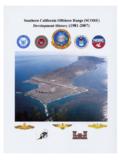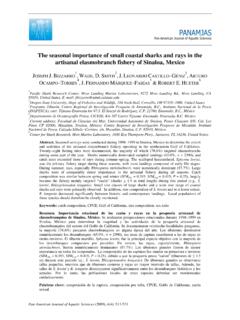Transcription of THE DAY I SHOT MYSELF DOWN - The Ejection Site
1 THE DAY I SHOTMYSELF DOWN80 FLIGHT JOURNAL Hey, I d like you to meet the guy who shot himself down . Quite often, that s howmy friends have introduced me. This unique honor belongs to me and anotherGrumman test pilot, Tommy Attridge, who did it in an F-11F-1 fighter that he flewinto a hail of 20mm rounds he had just fired during a supersonic gunnery test. Several yearslater, as a test pilot for Grumman Aerospace flying out of Point Mugu, California, I found amore modern way to do this using a Sparrow missile and the no. 6 F-14A Tomcat at thattime, the Navy s fighter of the future. Nearly 30 years later, that day June 20, 1973 remains sharp in my Pete PurvisThis is how it s supposed to go: the missile drops downfar enough to clear the airplane and then travels on itsmerry way (photo by Ted Carlson).
2 Four photos from the actual misfiring sequence show the severity of the flames from the initial firing; the failureof the missile to drop and properly clear the airframe; the missile dangerously close to the cockpit and the way-ward Aim-7 about to tumble away from us (official Navy photos by PH1 Bill Irving, courtesy of author).It wasn t a dark and stormy night. The midday sun wasbright in the clear blue southern California sky. TheChannel Islands off Point Mugu stood out in blue/gray starkrelief against the glistening ocean below as Bill Tank Sherman and I flew west toward the test area in the PacificMissile Test Range. Tank and I had known each other sincewe were in the same class in the Navy s F-4 replacement airgroup training.
3 He had a combat tour as a Navy radar inter-cept officer (RIO) and was good at his business: analytical,competent and cool the kind of guy you wanted to havealong when things got hectic. I had learned the real value ofa good RIO over North Vietnam while flying combat mis-sions in the F-4B Phantom from the USS Coral of the myriad development tests of a tactical air-plane is weapons separation, whether those weapons arebombs or missiles. That day, we were testing a critical pointin the Sparrow missile launch envelope. We weren t testingthe missile s ability to kill airplanes, only its ability to clearour airplane safely when fired. The crucial test point tookplace at.
4 95 Mach, at 5,000 feet altitude and at zero G, andit consisted of firing Raytheon AIM-7 Sparrow missiles fromthe farthest aft station (no. 4) in the tunnel that is underthe F-14 between the two engines where most missiles andbombs are hung. On the F-14, the Sparrow missiles aremounted in semi-submerged launchers in the tunnel withtwo of its eight cruciform wings (four forward, four aft)inserted into slots in each launcher. These triangular finsare 16 inches wide and, when the missile is attached to thelauncher, stick into the bottom of the fuselage. The test point for that day was in the heart of the low-altitude transonic range where the high-dynamic pressure-flow fields close to the fuselage are mysterious.
5 The zero Glaunch parameter meant the missile would not get any helpfrom gravity as it was pushed away from the airplane by thetwo semicircular feet embedded in the launcher mecha-nism. Each of these feet was attached to a cylinder that con-tained a small explosive charge that was set off by pullingthe trigger on the particular launch was not thought to be risky from apure separation standpoint because preceding Sparrowlaunches from the F-14 wing pylon, forward and mid-fuse-lage positions in identical flight conditions had demonstrat-ed favorable release dynamics and good clearance betweenthe missile and the aircraft throughout the entire launchsequence. In fact, Raytheon on the basis of its own aero-dynamic analysis was concerned that the missile wouldseverely pitch nose down as it had on two of the three priorlaunches at this condition, and possibly be so far below theaircraft as it passed the F-14 s nose radar that it could, in thereal world for which it was designed, lose the rear antennaF-14 SHOOTDOWN82 FLIGHT JOURNALPHOTOS COURTESY OF WARREN BODIEThe Raytheon AIM-7 Sparrow missile that misfired wasmounted on station (no.)
6 4) in the tunnel between theF-14 s two engines (photo by Ted Carlson).radar signal and compromise the target acquisi-tion portion of the missile trajectory. Raytheonengineers had predicted a two-foot Grumman wind tunnel tests con-firmed the Raytheon analysis. Such, however,was not to be the case for this launch. Hal Farley the other Grumman test pilotsharing the missile separation program and Ihad flown an extensive buildup series to get tothis critical data point. Flight-test programs arevery orderly evolutions. Engineers and testpilots study historical and forecast data carefully as testpoints progress from the mundane to the hazardous. Thisone was no different.
7 Neither Hal nor I had flown missileseparation tests before this series. And they didn t cover itat the Navy Test Pilot School, either. One of our Grummancolleagues, Don Evans a former Edwards USAF test pilotand one of the most experienced sticks in the outfit hadwarned us during flight test bonus discussions that forother than first flights, high-airspeed tests and structuraldemos, weapons separations were the most perilous, pri-marily because of their unpredictable nature. Hal and I lis-tened to Don, but his thoughts didn t sink in until we did abit of on-the-job training. We soon learned that, once theydeparted the mother airplane, stores sometimes had mindsof their own; they sailed away and were known to barrel-roll over the top or, perhaps, disintegrate ahead of the air-plane.
8 Once you ve seen that happen, you become wary ofstaying too close when chasing the test airplane. We oftenhad eager Navy pilots flying photo chase, and we had towarn them in no uncertain terms that this wasn t a BlueAngels the preflight briefing, the engineers once againdisplayed graphs that showed the predicted missile-to-fuse-lage clearance as a function of time after trigger pull. Asexpected, clearance was seen to be tight. But we had theutmost confidence in Grumman s lead separation engineer,Tom Reilly, and his data. All previous launch data used dur-ing buildups had come out on the money. We were good togo. The test missile was a dummy AIM-7E-2, an obsolescentmodel of the Sparrow with the same form, fit and functionas the AIM-7F, the missile scheduled for the Fleet.
9 The 7E-2 s casing, however, was slightly thinner than the 7F s. Themissile launcher feet contained a smaller charge becauseRaytheon s engineers thought a larger charge might fire thefeet with enough force to break the missile rest of the briefing was routine. As usual, F-14 no. 6 stest coordinator, Bob Mottl, was facilitator and ensured thatall the supporting cast had their moment. Tom gave us theusual five-inch stack of 5x7-inch index cards that detailedeach step of the test. Jim Homer, Grumman s range coordi-nator, briefed us on the boundaries of the test area and anarray of test frequencies and range procedures. Tank and Ibriefed our chase F-4 crew Lt. Col. Fritz Menning, USMC,from the VX-4 tactics development squadron (who hadchased many previous flights) and PH1 Bill Irving, the topaerial photographer at the Naval Missile Center, PointMugu.
10 After the routine ground checks, we took off andflew directly to our test location about 80 miles offshorebetween Santa Rosa and San Nicolas Islands, directly west ofLos test pilot in this case, the test crew has two prima-ry jobs: first, to hit a specific data point (aircraft attitude,altitude, airspeed, G loading) in the most efficient manner,and then relate unusual phenomena and analysis to thefolks back on the ground. On this day, the second part wascovered by several million dollars worth of test instrumen-tation. Very fortunate, because things were about to hit our point in the sky (567 KIAS, 5,000 feet, 0 G),and I pulled the trigger. Ka-whumpf!




